When painting a room, radiators are often forgotten and painted white out of habit.
Considering radiator paint in your colour scheme will help you to create a coordinated finish. Highlight radiators with a contrasting colour, or paint them in a complementary shade.
Where possible, we would advise painting your radiator before it is fitted; this will allow you to paint all surfaces with ease. However if this isn’t possible, you can simply paint the radiator in situ. Make sure to drain the radiator and ensure it is turned off during the application process.
Choosing a radiator paint finish
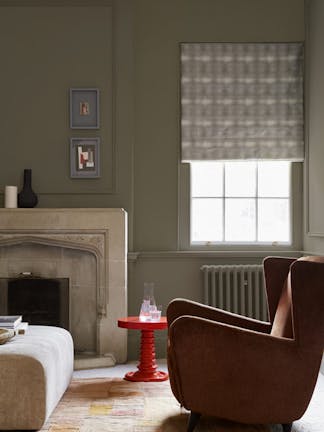
Intelligent Eggshell
Intelligent Eggshell is the perfect finish for radiators, it is formulated to resist moisture, staining and general wear and tear. Unlike all modern-day solvent-based paints, our Intelligent paint finishes are heat-resistant and guaranteed not to yellow upon exposure to high temperatures.
Intelligent Eggshell has a tough yet subtle finish and is a superb paint for woodwork and metalwork.
Its soft low sheen is:
- Self-priming
- Multi-surface with Intelligent Grip™ technology
- Environmentally-friendly
- Water-based
- Fully washable
- Suitable for most surfaces including walls, woodwork and primed metals such as radiators and radiator pipes
- Certified completely safe for children's rooms and furniture ('Toy Paint Regulations' EN 71-3:2019)
- Gloss level - 10-15% (low)
- Covers approximately 14 square metres per litre (one coat)
- Available in all colours
- Available in 3 tin sizes- 5L, 2.5L, and 1L
Note: Intelligent Eggshell is a type of paint that can be thinned as applied as a spray paint if desired. See the detailed Product Data Sheets for further guidance.
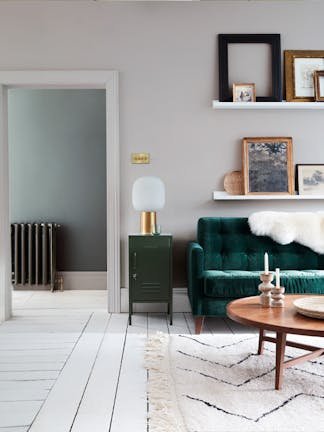
Intelligent Satin
For a beautiful mid sheen, Intelligent Satin can be used to paint all primed interior metals, including radiators.
This elegant satin paint finish is robust, hard-wearing and low maintenance. It can withstand everyday wear and tear, and its fully washable formula means any stains can easily be removed. With a speedy drying time of 2 hours, you can complete your radiator project in just one day.
Intelligent Satin is:
- Self-priming
- Multi-surface with Intelligent Grip™ technology
- Environmentally-friendly
- Water-based
- Fully washable
- Suitable for all interior woodwork and primed metals such as radiators
- Certified completely safe for children's rooms and furniture ('Toy Paint Regulations' EN 71-3:2019)
- Gloss level – 30-35% (mid sheen)
- Covers approximately 12 square metres per litre (one coat)
- Available in all colours
- Available in 2 tin sizes- 2.5L and 1L
Choosing radiator paint colours
When you're choosing a colour to paint your radiator, bear in mind the surroundings. Although whites or off-whites will be the obvious choices, oil-based paints can cause these colours to go yellow because of the temperature of the radiator. You can reduce the prominence of a radiator by using the same colour as the walls. Alternatively, you can make a statement by using a contrasting or complementary colour.
How to paint a radiator
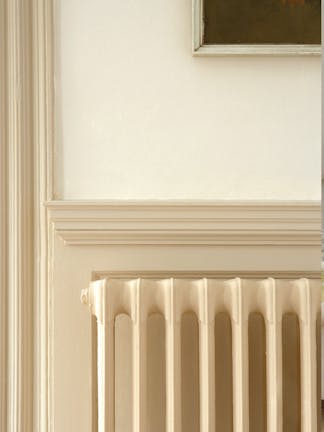
1. Prepare the surface of the radiator for painting
As with most painting projects, preparation is important. It will make all the difference between a beautiful professional finish and a rush job.
It is ideal if you can paint your radiator before it is plumbed in - or if you can take it down. This allows you to get better coverage on the hard-to-reach areas. However, be careful if it's already plumbed in. You'll need to drain the radiator first, so it might not be the best option if you've got a new carpet!
- If you're painting your radiator in situ, make sure you keep it turned off until the paint has dried.
- Ensure the room is well ventilated.
- Place protective dust sheets under the radiator to protect your flooring.
- Apply masking tape to any areas which meet a surface you don't intend to paint over.
How to prepare a previously painted radiator
Use a piece of medium grade sandpaper to smooth the surface. This will create a slightly rough surface that the paint will adhere to. If you have thick, unsightly paint or drip marks from a previous paint job, you may need to use a paint stripper to get a smooth finish.
Following sanding, thoroughly clean your radiator surface. Use a sponge and sugar soap or warm water and mild detergent before rinsing and allowing to dry. Cleaning the radiator helps to get rid of any dirt, dust and fluff. Any dirt trapped under a new coat of paint will be very noticeable, so it's worth the effort to clean thoroughly.
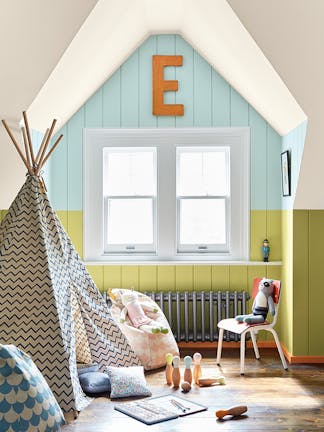
2. Prime the metalwork
It is vital to prime your radiator, to prevent staining and rust spots that could alter your chosen colour.
Choosing a radiator primer
If your radiator has not been painted before, or if the surface is damaged and worn, you will need to use a metal primer before painting. Our Intelligent All Surface Primer (ASP), can be applied to bare metal to provide an ideal surface for painting. ASP will help to prevent rust - this is particularly important for radiators, as they need to withstand high temperatures.
How to prime a radiator
1. Ensure that you have properly stirred the paint before you begin painting.
2. Using an angled paint brush, apply two coats of Intelligent ASP (All Surface Primer), which is tinted to a shade slightly lighter than your chosen topcoat to achieve full depth of colour.
3. Leave the undercoat to dry for 4 hours.
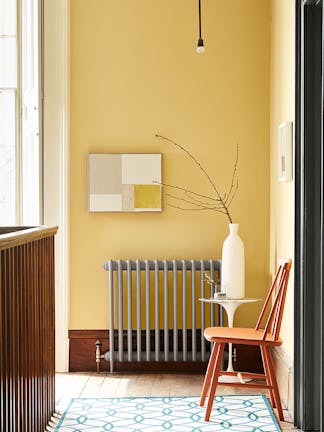
3. Paint the radiator
Once the undercoat is completely dry, you’re ready to apply the first coat of paint in your chosen shade.
You will usually need to apply two full paint coats over the primer for a professional finish.
If you are using Intelligent Eggshell, leave at least 4 hours between coats. You should allow the paint to dry fully for 48 hours before turning on the radiator.
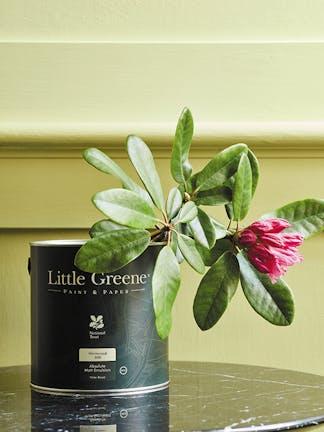
Radiator Painting Tips
- Stir your paint well before you start.
- Instead of a standard paint brush, you can use a radiator paint brush. These brushes are angled and designed to reach awkward places more easily,
- Avoid painting nuts and bolts or any moving parts, or you will have problems in future.
- Use even brush strokes for a smooth finish.
Radiator Painting FAQs
How to paint behind a radiator?
For best results, we recommend enlisting a professional plumber to remove the radiator from the wall, or painting the room before the radiator is fitted. This will allow you to reach all areas with ease and achieve full coverage.
Once the radiator has been removed, clean and rinse the wall before painting as normal. You should ask your plumber to refit the radiator only once the walls have completely dried.
If you would prefer to leave the radiator in place, you can use a radiator paint brush or radiator roller. These brushes/rollers are angled with a long handle to make it easier to reach tricky areas. Make sure to protect your radiator with masking tape to prevent any spills.
Can you paint a radiator with emulsion wall paint?
Use a paint suitable for radiators for a durable, long-lasting finish. We recommend our Intelligent Eggshell finish.
Can you paint radiators with gloss?
You can use Intelligent Gloss to paint radiators. With its distinctive high sheen of 87-90%, this traditional gloss finish is perfect for adding an element of textural contrast to your scheme.
As a water-based finish, Intelligent Gloss won’t yellow over time. It is virtually odourless and dries in 2-4 hours, so your project can be completed quickly.
You could also try Intelligent Satin for an elegant mid sheen of 30-35%.
How to paint a rusty radiator?
Treat any rust on your radiator before you apply the primer.
If your radiator has only slight surface rust, you should be able to get rid of it with sandpaper.
Browse our full colour palette in Intelligent Eggshell paint for radiators.

